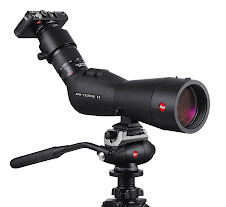 male Brown-throated Three-toed Sloth resting in a tree near Canopy Tower
male Brown-throated Three-toed Sloth resting in a tree near Canopy Tower In an earlier post I'd mentioned how Canopy Tower was an ideal location for digiscoping, but I didn't explain fully why that is. I will try to explain this more thoroughly and share some of the many pictures I was able to capture from the tower as well! Let me backtrack and review a bit for those that are perhaps just joining us. Digiscoping (at least as I practice it) is coupling a digital point & shoot camera like the Leica C-Lux 2 that I used behind the Leica APO Televid spotting scope for these pictures. Again my primary aim here (pun intended) is to capture wildlife images with the spotting scope that I carry most of the time in my pursuit of birds and wildlife anyway. As such, by simply adding a tiny camera and digital adapter to a hip pouch or shoulder strap, I'm ready to take stunning images at a moment's notice!
 Hoffman's Two-toed Sloth in trees at the Canopy Tower
Hoffman's Two-toed Sloth in trees at the Canopy TowerThe Canopy Tower offers an ideal situation for digiscoping not only because you are in the tree tops in a safe, stable structure with the creatures that utilize the canopy, but because many of these creatures are anywhere from 50 to 150 feet away. With patience most will come close enough for standard SLR and telephoto lenses, but I tend to be impatient and love the fact that this digiscoping set up allows me to achieve the equivalent of a 6,000 mm lens (120x magnification)!

Geoffrey's Tamarin digiscoped from Canopy Tower, July 2007
This allows me to get up close and personal with the wildlife even when it is farther away. The Geoffrey's Tamarin above was actually much closer but I still shot this at a 35 mm equivalent of a 1720 mm lens because I wanted to see it's whiskers! ;)
EXIF data:
35 mm equivalent on camera = 86 mm
scope zoom eyepice at 20 power
or 86 mm x 20x = 1720 mm equivalent lens.

Sloth hangs out at Canopy Tower
To put that into perspective, the longest telephoto lens readily available on the commercial market is an 800 mm lens. So even at nominal camera zoom I'm far exceeding the capabilities of most telephoto systems. Plus, an 800 mm lens can reach over 2 foot in length, weigh over 20 pounds, and force you to have to re-mortgage your house. ;p The Sloth above was actually scratching but I've entitled this shot "the Thinker!"

Mantled Howler Monkey (male) hangs down to get to Cecropia fruit
There's always a good assortment of mammals "hanging out" in the trees surrounding the Canopy Tower. Both of the aforementioned sloth species, preferred the loner approach but the troops of Monkeys always seemed to come through en masse. The small Tamarins were less numerous and came and went quickly during our stay, but the Howlers were regular and numerous throughout our stay. One guest told me that the large wound on the side of the male above was a Bot Fly larvae, but don't know this for certain. Seems plausible. He explained that Vampire Bats can often make the initial wound and allow the Bot Fly to get under the flesh. Makes for a good story but I can't say for certain if this is the case.
Does anyone reading know more about this relationship or hypothesis?... would love some feedback.
 male Howler Monkey stares intently at some distant subject
male Howler Monkey stares intently at some distant subject The ever vociferous and social Howlers were a treat to watch. Even though they are a common species throughout much of the Neotropics, I don't see these in the wild here in Florida so it was a great treat.

female Howlers with tail at the ready feeds on tree top fruit
The female Howlers were notably slimmer and smaller than the mature males lacking the distinct "mane" shown by the latter. The animal above was taking full advantage of fruiting Cecropia that surrounds the Tower. It is also worthy of note that this is not a tower in the typical sense (a narrow spire sticking up) but more of a very wide 4 story building with large observation deck ringing the top. This allows easy panoramic viewing options in any direction which is also advantageous for viewing the birds and wildlife moving through the tree-tops. It's a very unique and beautiful perspective for observing the "Canopy Express".

Mantled Howler Monkey digiscoped July 2007, Canopy Tower
I can't wait!


Great pics. I got a 1200mm Nikon prime lens recently pretty cheap, and I am surprised what brilliant shots you can get with a sports optics.
ReplyDeleteI recently came across your post and have been reading along. I thought I would leave my first comment. I don't know what to say except that it caught my interest and you've provided informative points. I will visit this blog often.
ReplyDeletethanks both. It's always fun.
ReplyDelete